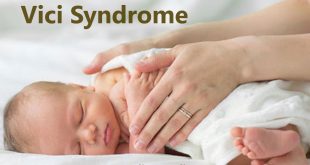Definition
Albinism includes a group of inherited disorders that are characterized by little or no production of the pigment melanin. The type and amount of melanin your body produces determines the color of your skin, hair and eyes. Most people with albinism are sensitive to sun exposure and are at increased risk of developing skin cancer.
Albinism
Epidemiology
The occurrence rate of albinism in our study was 20.4% of genodermatoses patients and 1 per 5843 patients attending the Pediatric hospital. Consanguineous marriage was reported among parents of 66.37% of patients and positive family history was reported in 46.01% of patients. Complete OCA was detected in 48.59% of patients, partial albinism in 41.59% of patients and syndromic albinism was detected in 7.96%. Associated genomic errors were detected in 36.28% of our albino patients and seventy-one multiple mutant genomic errors were defined among relatives of thirty-seven index families of oculocutaneous albinism patients.
Types of Albinism
Types of albinism, based mainly on which mutated gene caused the disorder, include:
Oculocutaneous albinism: Oculocutaneous (ok-u-low-Ku-TAY-nee-us) albinism is caused by a mutation in one of four genes. People with oculocutaneous albinism (OCA) type 1 have milky white skin, white hair and blue eyes at birth. Some people with OCA type 1 never experience an increase in pigmentation, but others begin to produce melanin during early childhood. Their hair may become a golden blond, brown or red, and their irises may change color and lose some translucence.
OCA type 2 is most common in sub-Saharan Africans, African-Americans, and Native Americans. The hair may be yellow, auburn, ginger or red, the eyes can be blue-gray or tan, and the skin is white at birth. With sun exposure, the skin may, over time, develop freckles, moles or lentigines.
People with OCA type 3, mainly found in black South Africans, usually have reddish-brown skin, ginger or reddish hair, and hazel or brown eyes. OCA type 4 looks similar to type 2 and is most often found in people of East Asian descent.
X-linked ocular albinism: The cause of X-linked ocular albinism, which occurs almost exclusively in males, is a gene mutation on the X chromosome. People who have ocular albinism have vision problems, but their skin, hair and eye color are generally in the normal range or slightly lighter than that of others in the family.
Hermansky-Pudlak syndrome: Hermansky-Pudlak syndrome is a rare albinism disorder caused by a mutation in one of at least eight different genes. The disorder is much more common in Puerto Rico. People with this disorder have signs and symptoms similar to people with oculocutaneous albinism, but they may also develop lung and bowel diseases, or a bleeding disorder.
Chediak-Higashi syndrome: Chediak-Higashi syndrome is a rare form of albinism associated with a mutation in the LYST gene. With signs and symptoms similar to oculocutaneous albinism, the hair is usually brown or blond with a silvery sheen, and the skin is usually creamy white to grayish. People with this syndrome have a defect in white blood cells that increases their risk of infections.
Risk factors
- Genetic Predisposition to Disease
- Family history of the disorder
Causes
- It is caused by a mutation in one of several genes. The genes in question are responsible for various aspects of the production of melanin by melanocytes in the skin and eyes.
- Most commonly, the mutations interfere with the enzyme tyrosinase (tyrosine 3-monooxygenase) which synthesizes melanin from the amino acid tyrosine.
- Depending on the mutation, melanin production can either be slowed or completely stopped. But, regardless of the amount of interference with melanin production, there are always associated problems with the visual system in albinism.
- These vision problems occur because of melanin’s vital role in the development of the retina and the optic nerve pathways from the eye to the brain.
Symptoms of Albinism
People with albinism will have the following symptoms:
- an absence of color in the hair, skin, or eyes
- lighter than normal coloring of the hair, skin, or eyes
- patches of skin that have an absence of color
Albinism occurs with vision problems, which may include:
- strabismus (crossed eyes)
- photophobia (sensitivity to light)
- nystagmus (involuntary rapid eye movements)
- impaired vision or blindness
- astigmatism
Albinism complications
Complications includes skin disorders as well as social and emotional challenges.
Skin disorders
One of the most serious complications associated with albinism is the risk of sunburn and skin cancer.
Social and emotional factors
The reactions of other people to those with albinism can often have a negative impact on people with the condition.
- Children with albinism may experience name-calling, teasing or questions regarding their appearance, eyewear or visual aid devices.
- Many people with albinism find the word “albino” hurtful because they’re being labeled simply on the basis of looks rather than being thought of as individuals.
- People with this usually look very different from members of their own families or ethnic groups, so they may feel like outsiders or be treated as outsiders.
All of these factors may contribute to social isolation, poor self-esteem and stress.
Diagnosis and test
A complete diagnostic workup includes:
- Physical exam
- Description of changes in pigmentation
- A thorough exam of the eyes
- Comparison of your child’s pigmentation to that of other family members
A medical doctor specializing in vision and eye disorders (ophthalmologist) should conduct your child’s eye exam. The exam will include an assessment of potential nystagmus, strabismus, and photophobia. The doctor will also use a device to visually inspect the retina and determine if there are signs of abnormal development. A simple test can measure the brain waves produced when light or a reversing pattern is flashed into each eye. This can indicate the presence of misrouted optical nerves.
If your child has only one eye impairment, such as nystagmus, another condition may be the cause. Disorders other than this can affect skin pigmentation, but these don’t cause all of the visual problems associated with albinism.
Treatment and medications
- Because the disease is genetic, there are no cures; treatment revolves around minimizing the symptoms and watching for changes.
- Getting the right care for eye problems is essential, including prescription glasses, dark glasses to protect the eyes from the sun, and regular eye exams. It is also important to watch the skin for changes and to use sunblock for protection.
- Surgery on the optical muscles can sometimes minimize the “shaking” in nystagmus. Similarly, operations to minimize strabismus can make it less noticeable. The surgery does not improve vision, however, and the level of success in reducing symptoms varies from individual to individual.
- Albinism does not get worse with age, and a child with albinism is able to flourish and achieve the same education and employment as a person without the condition.
Prevention
If a family member has albinism, a genetic counselor can help you understand your chances of having a future child with albinism. He or she can also explain the available tests and help you figure out the pros and cons of testing for your family member.
 Diseases Treatments Dictionary This is complete solution to read all diseases treatments Which covers Prevention, Causes, Symptoms, Medical Terms, Drugs, Prescription, Natural Remedies with cures and Treatments. Most of the common diseases were listed in names, split with categories.
Diseases Treatments Dictionary This is complete solution to read all diseases treatments Which covers Prevention, Causes, Symptoms, Medical Terms, Drugs, Prescription, Natural Remedies with cures and Treatments. Most of the common diseases were listed in names, split with categories.








sorry if i feel offended by the exposure of albinisam as disorder but no race, for i am a gypsy who race is by blood. you please do not take it offensive if i say you health performance take your place at giving advice and let the individual rights take place so on being albino without discrimination in aspective perspective for a recognised race. me as gypsy have to understand your meaning for you do not have blood tests to prove a gypsy genome, even at white family members, to count colour.